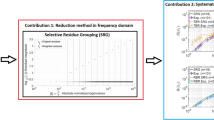Abstract
In this paper the authors consider a parameter estimation problem for a nonlinear systems, which consists of one parabolic equation for the concentration and two elliptic equations for the potentials. The measurements are given as boundary values for one of the potentials. For its numerical solution the Gauss Newton method is applied. To speed up the solution process, a reduced-order approach based on proper orthogonal decomposition is utilized, where the accuracy is controlled by error estimators. Parameters, which can not be identified from the measurements, are identified by the subset selection method with \(QR\) pivoting. Numerical examples show the efficiency of the proposed approach.

Similar content being viewed by others
References
Adams, R.A.: Sobolev Spaces. Pure and Applied Mathematics, vol. 65. Academic Press, New York (1975)
Alt, H.W.: Lineare Funktionalanalysis: Eine anwendungsorientierte Einführung, 5th edn. Springer, Berlin (2006)
Batzel, J.J., Fürtinger, S., Bachar, M., Fink, M., Kappel, F.: Sensitivity identifiability of a baroreflex control system model. Technical report. Graz University of Technology, (2009)
Burth, M., Verghese, G.C., Vélez-Reyes, M.: Subset selection for Improved parameter estimation in on-line identifiaction of a synchronous generators. IEEE Trans. Power Syst. 14(1), 218–225 (1999)
Cai, L., White, R.E.: Reduction of model order based on proper orthogonal decomposition for lithium-ion battery simulations. J. Electrochem. Soc. 156(3), A154–A161 (2009)
Dautray, R., Lions, J.L.: Mathematical Analysis and Numerical Methods for Science and Technology. Volume 5: Evolution Problems I. Series Computational Mathematics. Addison-Wesley, Springer (1992)
Deuflhard, P.: Newton Methods for Nonlinear Problems. Affine Invariance and Adaptive Algorithms. Series Computational Mathematics. Springer, Berlin (2004)
Dihlmann, M., Haasdonk, B.: Certified PDE-constrained parameter optimization using reduced basis surrogate models for evolution problems. Comput. Optim. Appl. 16, 1–35 (2013)
Evans, L.C.: Partial Differential Equations. American Mathematical Society, Providence (2002)
Fink, M., Attarian, A., Tran, H.: Subset selection for parameter estiamtion in an HIV model. Proc. Appl. Math. Mech. 7, 1121501–1121502 (2007)
Fuller, T., Doyle, M., Newman, J.: Modeling of galvanostatic charge and discharge of the lithium ion battery/polymer/insertion cell. J. Chem. Soc. 140(6), 1526–1533 (1993)
Golub, G.: Numerical methods for solving least squares problems. Numer. Math. 7, 206–216 (1965)
Gubisch, M., Volkwein, S.: Proper Orthogonal Decomposition for Linear-Quadratic Optimal Control. Technical report, University of Konstanz, (2013)
Grepl, M.: Certified reduced basis method for nonaffine linear time-varying and nonlinear parabolic partial differential equations. WSPC Math. Mod. Methods Appl.Sci. 22(3), 441–449 (2012)
Gu, M., Eisenstat, S.C.: Efficient algorithms for computing a strong rank-revealing QR factorization. SIAM J. Sci. Comput. 17, 848–869 (1996)
Haasdonk, B.: Convergence rates of the pod-greedy method. ESAIM Math. Mod. Numer. Anal. 46, 491–511 (2012)
Hinze, M., Pinnau, R., Ulbrich, M., Ulbrich, S.: Optimization with PDE Constraints. Springer, Amsterdam (2009)
Holmes, P., Lumley, J.L., Berkooz, G., Rowley, C.W.: Turbulence, Coherent Structures, Dynamical Systems and Symmetry. Cambridge Monographs on Mechanics, 2nd edn. Cambridge University Press, Cambridge (2012)
Kammann, E., Tröltzsch, F., Volkwein, S.: A method of a-posteriori error estimation with application to proper orthogonal decomposition. ESAIM: M2AN 47, 933–934 (2013)
Kelley, C.T.: Iterative Methods for Optimization. Society for Industrial and Applied Mathematics, Philadelphia (1999)
Kunisch, K., Volkwein, S.: Galerkin proper orthogonal decomposition methods for parabolic problems. Numer. Math. 90, 117–148 (2001)
Lass, O.: Reduced-order modeling and parameter identification for coupled nonlinear PDE systems. Ph.D thesis, University of Konstanz, (2014)
Lass, O., Volkwein, S.: POD Galerkin schemes for nonlinear elliptic-parabolic systems. SIAM J. Sci. Comput. 35(3), A1271–A1298 (2013)
Maday, Y., Nguyen, N.C., Barrault, M., Patera, A.T.: An ’empirical interpolation’ method: application to efficient reduced-basis discretization of partial differential equations. C. R. Math. 339(9), 667–672 (2004)
Nocedal, J., Wright, S.J.: Numerical Optimization. Springer, New York (2006)
Patera, A.T., Rozza, G.: educed Basis Approximation and A Posteriori Error Estimation for Parametrized Partial Differential Equations. MIT Pappalardo Graduate Monographs in Mechanical Engineering. MIT, Cambridg (2006)
Reid, J.G.: Structural identifiability in linear time-invariant systems. IEEE Trans. Autom. Control 22, 242–246 (1977)
Seger, T.: Elliptic-parabolic systems with application to lithium-Ion battery models. PhD thesis, University of Konstanz, (2013)
Sirovich, L.: Turbulence and the dynamics of coherent structures. parts i-ii. Quart. Appl. Math. 10, 561–590 (1987)
Tröltzsch, F.: Optimal Control of Partial Differential Equations. Theory, Methods and Applications. American Mathematical Society, Providence (2010)
Vogel, C.R.: Computational Methods for Inverse Problems. Frotiers in Applied Mathematics. SIAM, Philadelphia (2002)
Vutov, Y., Mergenov, S., Popov, P., Iliev, O.: Finite volume discretization of equations describing nonlinear diffusion in li-ion batteries. Numer. Methods Appl. Lect. Notes Comput. Sci. 6046, 338–346 (2011)
Xu, J., Wu, J., Zou, H.: On the well posedness of mathematical model for lithium-ion battery systems. Methods Appl. Anal. 13, 275–298 (2006)
Acknowledgments
The authors gratefully acknowledges support by the German Science Funds Numerical and Analytical Methods for Elliptic-Parabolic Systems Appearing in the Modeling of Lithium-Ion Batteries (Excellence Initiative) and DFG grant VO 1658/2-1 A-posteriori-POD Error Estimators for Nonlinear Optimal Control Problems governed by Partial Differential Equations
Author information
Authors and Affiliations
Corresponding author
Rights and permissions
About this article
Cite this article
Lass, O., Volkwein, S. Parameter identification for nonlinear elliptic-parabolic systems with application in lithium-ion battery modeling. Comput Optim Appl 62, 217–239 (2015). https://doi.org/10.1007/s10589-015-9734-8
Received:
Published:
Issue Date:
DOI: https://doi.org/10.1007/s10589-015-9734-8




